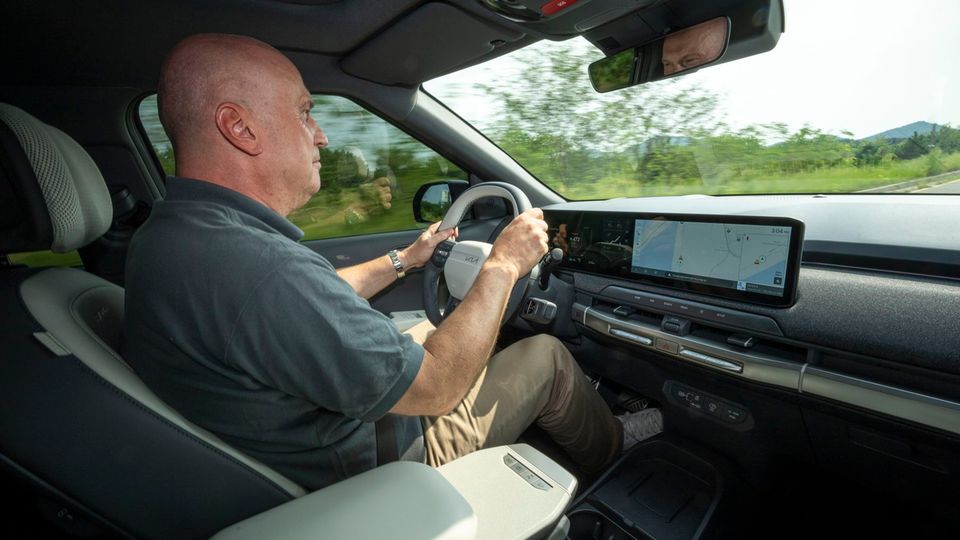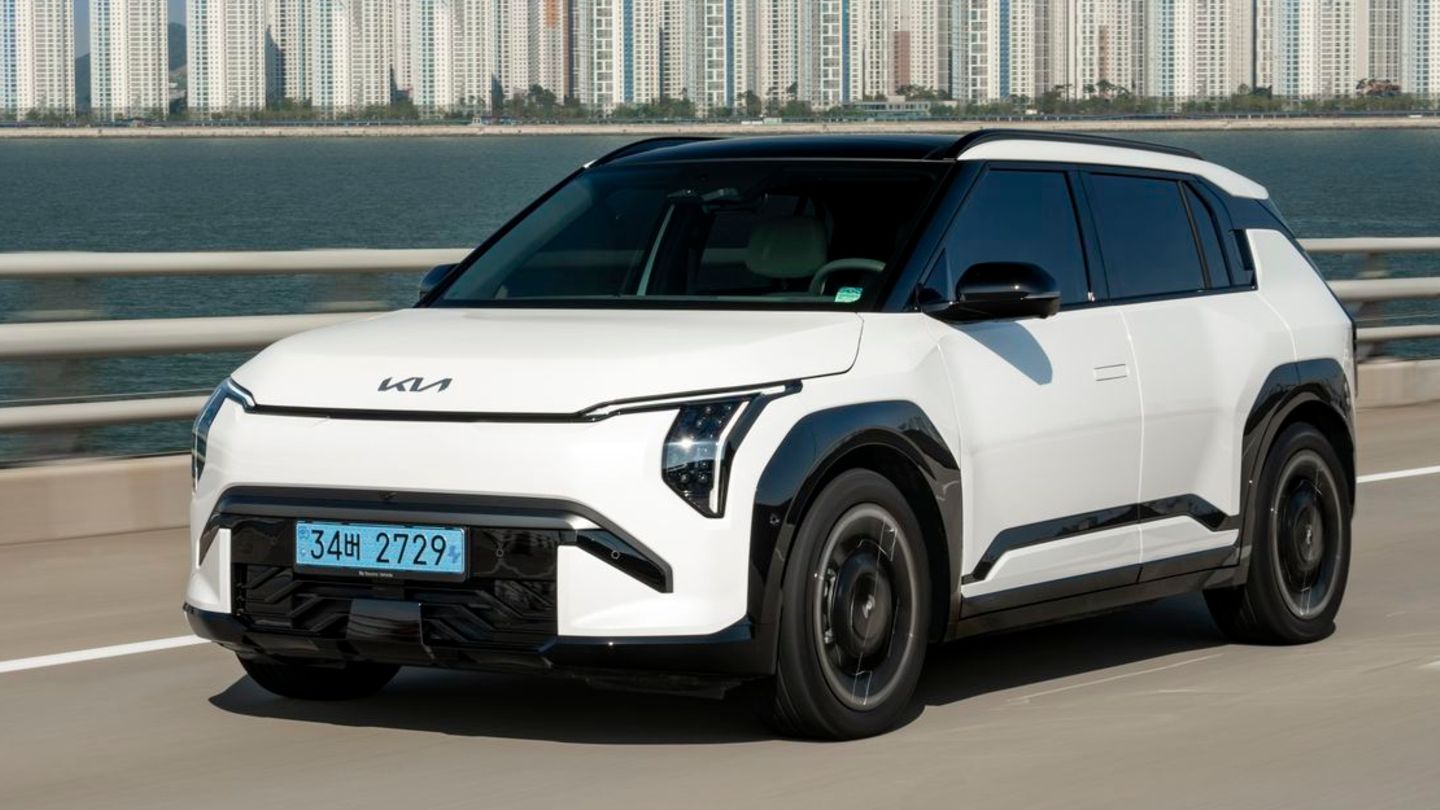After the Kia Soul comes the Kia EV3. The compact electric SUV competes against the Volvo EX30, the Smart #1 and the Peugeot 2008 and has many strengths, but unfortunately is not perfect.
Every now and then there are cars that trigger an “Wow” effect. Hip motorists then rave about a statement car in the best marketing speak. The rolling dice played a key role in Kia shedding its image of the grey mouse and becoming a trend brand for younger drivers. When the Soul rolled across the asphalt as a fully electric EV, the step into the automotive future was taken. But as always in life, even the good things come to an end at some point and so this year was the Soul’s last hour. It is clear that the Koreans are not leaving the compact BEV SUV segment without a fight. Due to the new nomenclature of the Hyundai subsidiary, it could no longer be a Soul, but the EV3. But that does not mean that the successor is soulless. Quite the opposite: This compact Korean crossover shows edge, but does not exaggerate. So the design is pleasing, but not ordinary.
With a length of 4.30 meters, the EV3 fits in with the Volvo EX30, Lexus LBX and Smart #1. Its corporate brother, the Hyundai Kona, is three centimeters longer than this. Nevertheless, you won’t get claustrophobic in the Kia EV3. Not in the back and certainly not in the front. However, the driver and front passenger would appreciate a longer leg rest and more lateral support. This means you’re more perched on the seat than sitting in it. Since the EV3 isn’t a sports car, this isn’t a big deal.
More important is the fact that even as an adult, there is enough space in the back to travel comfortably. The trunk, with a capacity of 460 liters, does not turn into a better handbag. If you fold down the back seat backrests, you have a flat loading floor and then up to 1,251 liters can fit in, including the compartment underneath. However, the loading sill is quite high. There is a 25-liter frunk at the front for the charging cable. Incidentally, the EV3 already supports Vehicle-to-Load (V2L). This means that you can also connect and operate electrical household appliances.
Kia EV3: Not cheap at all
The interior exudes a pleasant atmosphere. However, the top-of-the-range GT Line equipment we drove also comes at a price of at least 48,690 euros. We also took a closer look at the basic “Air” version of the Kia EV3 (from 35,990 euros) and this interior is also a welcome change from the hard plastic ambience of a first-generation VW ID3. The plastic surfaces of the dashboard are grained and in some cases even foamed. No sign of cheapness.
The three standard screens are combined in a slightly curved unit and have a size of 30 inches. This consists of two 12.5-inch monitors and a five-inch control unit for the air conditioning, which is located between the digital cockpit and the infotainment touchscreen. The only problem is that it is somewhat obscured by the steering wheel rim. It is good that there are still classic analog levers and buttons in the center console. There is also little to complain about with the infotainment system; even without Kia insider knowledge, you can quickly find your way around the menus and the optional head-up display (costs 1,290 euros in the package) completes the display concept.

There are two battery sizes to choose from for the Kia EV3: The capacity of 58.3 kilowatt hours is enough for a maximum of 436 kilometers, while the 81.4 kWh batteries are good for 605 kilometers, which is quite a challenge in this segment. With this battery, we achieved an estimated range of 544 kilometers in a warm 31 degree outside temperature, which is pretty close to the stated value of 563 km (with 19-inch wheels). NMC cells (nickel-manganese-cobalt) are used as energy storage, and instead of the 800-volt technology often used by the Hyundai Group, the Kia EV3 uses 400 volts for cost reasons, which is quite understandable in such a price-sensitive segment as the compact class.
What will not cause any great enthusiasm, however, is the charging power. While 11 kW is perfectly acceptable for AC charging, the maximum charging speed at a DC charging station is average at best: for the small battery it is 101 kW and for the large one 128 kW. In absolute terms, this is 7:15 hours (81.4 kWh batteries) or 5:20 hours at a wallbox to fill the storage from ten to 100 percent. With fast charging, it takes 29 minutes (58.3 kWh) or 31 minutes for ten to 80 percent.
This is how the compact SUV drives
The Korean electric car cuts a fine figure when driving. At the beginning of 2026, the EV3 will initially only be available in Germany with front-wheel drive and 150 kW / 204 hp and 283 Newton meters of torque, later followed by an all-wheel drive version with probably 125 kW / 170 hp at the front and 70 kW / 95 hp at the rear. The top model will be the Kia EV3 GT with probably 145 kW / 197 hp and 75 kW / 102 hp on the rear axle. Even the basic PS version is powerful enough to quickly maneuver the two-ton vehicle around.
From a standstill, 100 km/h is reached in 7.9 seconds, but the top speed is already at 170 km/h. The Eco, Normal and Sport driving modes only differ marginally in the response of the accelerator pedal. The steering wheel’s return force is also increased. There are also two driving programs: one individual and one for snow.

Our test vehicle was fitted with 19-inch wheels, which is not particularly conducive to comfort. Despite this, the Kia EV3 does not torture the spinal discs. The chassis is comfortably tuned. You can feel that the springs have to bear the weight and the dampers are responsible for comfort, but the tuning is more harmonious than in many other electric cars. Transverse joints do not upset the chassis and on more pronounced bumps the body does wobble, but it is less pronounced than in other vehicles.
This means that you can travel in a relaxed manner in the Kia EV3, even on longer journeys. The compact crossover is also the first car from the Hyundai Group to be equipped with the iPedal 3.0. This means intelligent recuperation that also reacts to traffic. A total of three recuperation levels plus zero (sailing) are available. One-pedal drive is therefore possible.
After the EV3, whose production begins at the end of next year, comes the smaller EV2. Kia boss Ho Sung Song is aware of the fact that the commercial success of electromobility can only be achieved through price: “We are working hard to bring an even cheaper electric car onto the market. 30,000 euros will be difficult. 25,000 euros is the lower limit for me. Because we do not compromise on the quality and the special features that make a Kia.” This means that the EV2, whose production begins at the end of next year, will probably cost just under 30,000 euros. The EV1 will take up the price gauntlet and cost around 25,000 euros. An important lever for realizing these prices will be the battery. So it will be interesting to see what happens.
Source: Stern
I’m a recent graduate of the University of Missouri with a degree in journalism. I started working as a news reporter for 24 Hours World about two years ago, and I’ve been writing articles ever since. My main focus is automotive news, but I’ve also written about politics, lifestyle, and entertainment.




